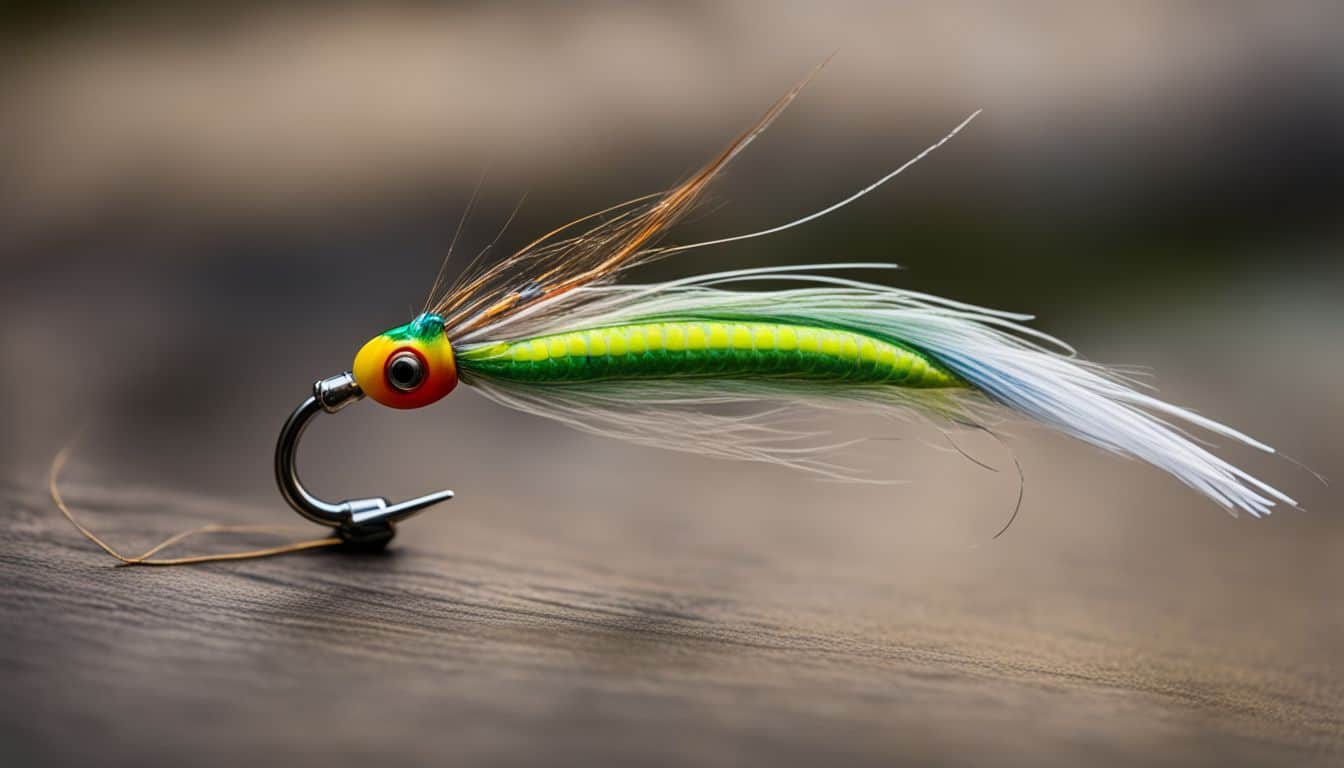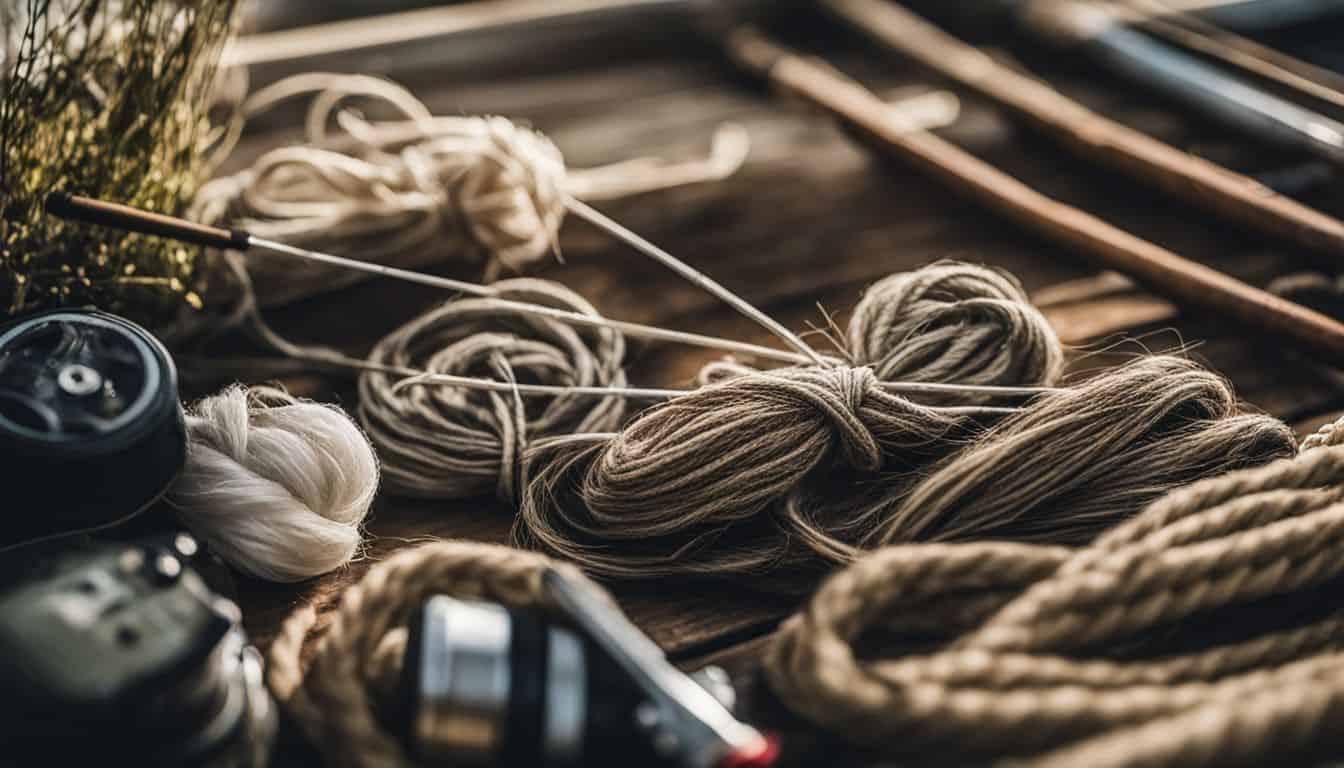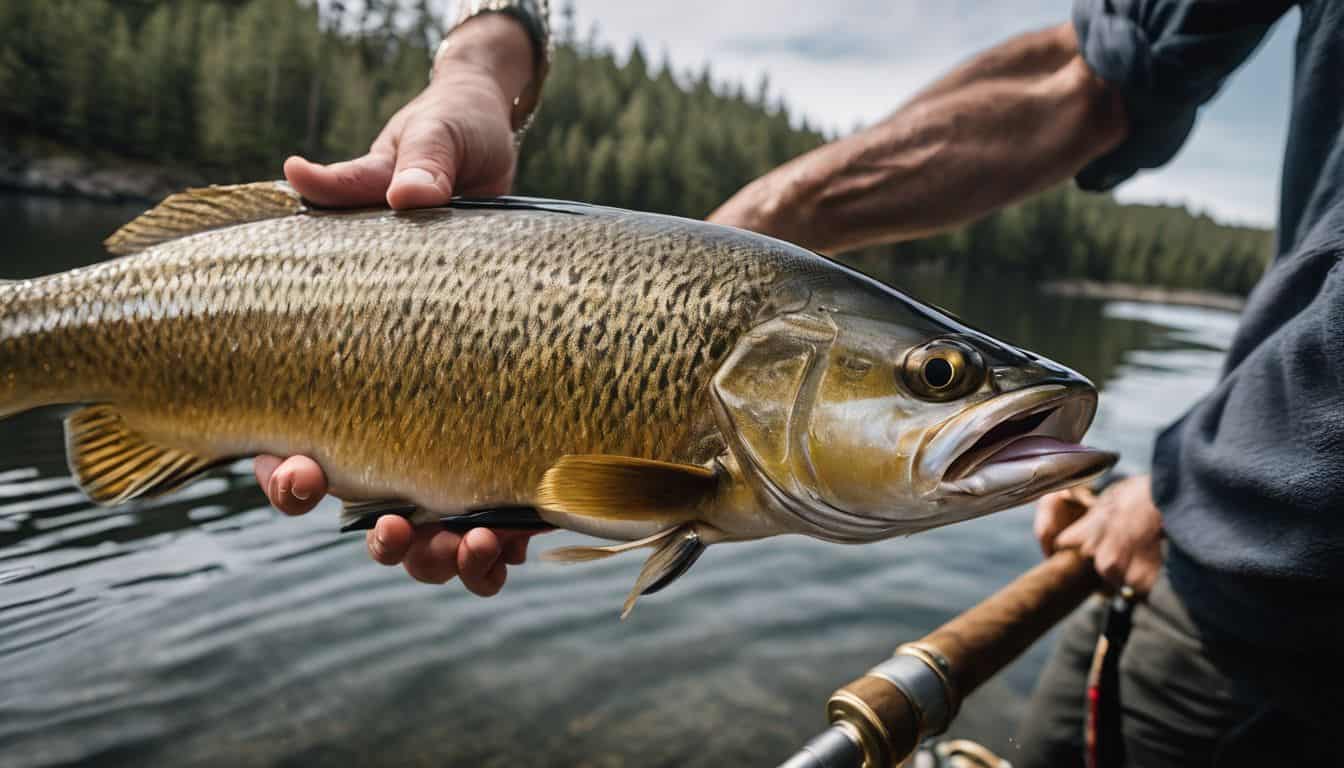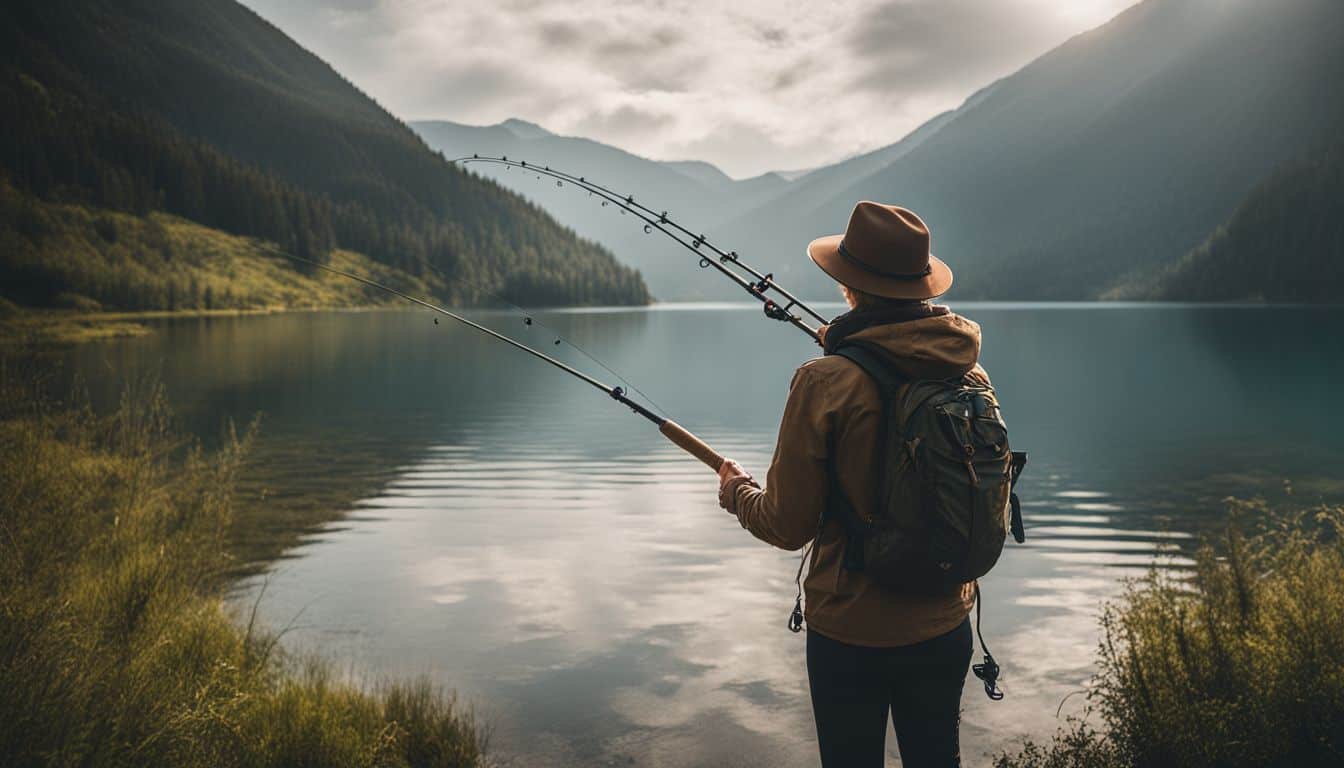Tying a robust, trusty fishing knot is often a bit of a doozy for many anglers. I get it – after numerous tangled lines and seemingly aloof fish, I too came to grasp the true importance of honing this skill.
That’s precisely why in this article, we’re going to delve into three crucial tips that will help you tie fishing knots akin to an expert. So gear up and prepare to elevate your angling prowess with these tried-and-true techniques!
Key Takeaways
- Tying good fishing knots is crucial for successful angling, as it maintains the strength of your line. Knots that keep at least 90% of the line’s power are recommended.
- The Improved Clinch Knot, Palomar Knot, and Egg Loop Knot are fundamental fishing knots every angler should know. These knots provide a strong and secure connection between the line and hook or lure.
- Advanced fishing knots like the Rapala Knot, Albright Knot, and Surgeon’s Knot can be used in special situations where extra strength is needed. These knots are known for their reliability and durability.
- To tie stronger knots, practice without looking at your hands or the line to develop muscle memory. Threading the line through the hook eye first is important. Exploring alternative knot options like Orvis knot or double line knot can provide extra strength. Following proper technique guidelines and avoiding shortcuts ensures strong connections.
- Trimming excess line after tying a knot helps prevent tangles and snags while wetting the line before tightening reduces friction for stronger knots.
- Maintaining knots during fishing involves wetting the line before pulling it tight, checking tightness regularly, inspecting and reinforcing weakened or damaged areas of the knot.
Importance of Mastering Fishing Knots
Tying good knots is key for great fishing. I found this out when I went to Ontario’s Algoma Country. Knots can lower the line’s power, so they must be top-notch. Using knots that keep at least 90% of the line strength is a wise move.
Knot tying skills make or break your fishing game. The right knot gives a safe link between the line and hook or lure. This helps catch fish easier. So, keeping knots tight and snug matters big time! Let’s not forget – practice makes perfect here too!
Basic Fishing Knots Every Angler Should Know
The Improved Clinch Knot is a fundamental knot that every angler should know, as it provides a strong and reliable connection between the fishing line and the lure or hook.
Improved Clinch Knot
This knot is a must-know for all anglers. The Improved Clinch Knot is used to tie a fishing line to a hook, lure, swivel, clip or fly. This knot has more grip than the regular Clinch Knot.
It’s easy to make and widely known.
You can use this knot with small to medium-sized hooks, lures or swivels. Its strength helps it stand strong when fish pull on your line. Mastering this knot will help you catch more fish and have fun while doing so!
Palomar Knot
The Palomar Knot is a top choice for anglers. You use it to attach the line to your hook or fly to the leader. It’s very strong and won’t let you down when catching fish. There are different ways to make this knot, based on the type of fishing line used.
Braid, fluoro, or mono – all work well with this reliable knot!
Egg Loop Knot
The egg loop knot is a really useful knot when you’re fishing for salmon or steelhead trout. It can securely hold soft baits, like eggs, on your hook. This knot is known for being strong and reliable, so it’s a great choice when you’re using soft baits in your fishing.
You can tie the egg loop knot with different types of fishing lines, such as monofilament, fluorocarbon, or braid. Mastering this knot can really improve your success when fishing with soft baits.
Advanced Fishing Knots for Special Situations
In special situations, advanced fishing knots can make a big difference. Discover the secrets to tying the Rapala Knot, Albright Knot, and Surgeon’s Knot for those challenging scenarios.
Rapala Knot
The Rapala Knot is a strong and reliable choice for attaching artificial lures and hooks when targeting large fish species. It is considered one of the best loop knots for special situations where strong knots are necessary.
This knot does not slip, making it a great option for securely attaching lures directly to the line. It’s important to note that the Rapala Knot is specifically designed for use with Rapala lures, so it’s recommended to use this knot with those types of lures.
Overall, the Rapala Knot is known for its strength and is considered one of the strongest loop knots available for angling purposes.
Albright Knot
The Albright Knot is a handy fishing knot that can be used in many different situations. It’s moderately easy to tie and is great for connecting one line to another. You can use the Albright Knot when you want to connect braided line to mono or fluorocarbon line.
It’s a versatile knot that can help you strengthen your line connection and improve your fishing technique. So, if you’re looking for a reliable and strong knot for your fishing tackle, give the Albright Knot a try!
Surgeon’s Knot
The Surgeon’s Knot is a strong and reliable fishing knot that anglers use to join two strands of fishing line together. It’s an advanced knot that is known for its durability. Many anglers use the Surgeon’s Knot when they need to connect lines with different diameters or materials, such as when using fluorocarbon leaders or attaching a braided mainline to a monofilament leader.
This versatile knot can be used for various fishing techniques, whether you’re freshwater fishing or saltwater fishing. So, if you want a secure and trustworthy connection between your lines, mastering the Surgeon’s Knot is definitely worth it!

Essential Tips for Tying Knots Like a Pro
Tying fishing knots like a pro is essential for any angler. Here are some tips to help you improve your knot-tying skills:
- Develop a feel for the knots: Practice tying knots without looking at your hands or the line. This will help you develop a tactile sense and muscle memory for tying knots quickly and efficiently.
- Threading the line through the hook eye: Make sure to thread the end of the fishing line through the eye of the hook or lure before starting to tie your knot. This is an important first step in securing your fishing knot.
- Create a loop with the free end: After threading the line through the hook eye, create a loop with the free end of the line. Pass this loop through the eye of the hook, ensuring that it is large enough to easily manipulate.
- Explore alternative knot options: While some knots like the improved clinch knot or palomar knot work well in most situations, it’s worth exploring other options like the Orvis knot or double line knot. These alternatives can provide extra strength and security for certain types of fishing.
- Follow guidelines and avoid shortcuts: It’s crucial to follow proper knot tying guidelines to ensure that your knots are strong and secure. Avoid taking shortcuts or rushing through tying your knots, as this can lead to weak connections and potentially lost fish.
Strengthening Your Knots
To make your knots stronger and more reliable, there are a few practical tips you can follow. One tip is to moisten the knot with water or saliva before tightening it, as this helps reduce friction and prevents the line from weakening.
Another tip is to inspect your knots regularly while fishing and reinforce them if necessary by adding an extra turn or two. Additionally, always maintain your knots during fishing by checking for any signs of wear or damage and retieing them if needed.
By following these steps, you can ensure that your fishing knots will hold strong when it counts.
Practical tips for stronger knots
To tie stronger knots for fishing, here are some practical tips:
- Use lubrication: Apply a small amount of saliva or water to the knot before tightening. This helps prevent friction and heat, making the knot stronger.
- Choose the right knot: Different knots have different strengths and purposes. Make sure to use the appropriate knot for your fishing needs. The improved clinch knot and palomar knot are commonly used and reliable choices.
- Inspect your knots: Before casting, give your knots a thorough inspection. Look for any signs of fraying or weakness. If you find any issues, simply retie the knot to ensure its strength.
- Practice proper technique: When tying knots, make sure to maintain tension on the line throughout the process. This helps ensure a tight and secure knot.
- Avoid over-tightening: While it’s important to have a tight knot, be careful not to over-tighten as this can weaken the line or cause it to break.

Inspecting and reinforcing your knots
Inspecting and reinforcing your knots is essential to ensure their strength and reliability. Here are some important tips to help you:
- Examine your knots: After tying a knot, take a close look at it to make sure it is properly formed. Check for any twists or tangles in the line and ensure the knot is tight and secure.
- Trim excess line: Trim any excess line after tying your knot. This will not only give your setup a neater look but also prevent tangles and snags while casting or reeling in your catch.
- Wet the line: Before pulling the knot tight, wet the line with water or saliva. This helps reduce friction and heat when tightening the knot, increasing its strength and durability.
- Test your knots: Give your knots a gentle tug to test their strength before casting or starting your fishing session. If a knot feels loose or slips easily, untie it and retie it using proper techniques.
- Reinforce weak points: Pay attention to any weak points in your knots, such as where the tag end of the line meets the mainline. You can reinforce these areas by using an additional wrap or making a double overhand loop before completing the knot.
- Use appropriate knots for different situations: Different fishing scenarios may require specific knots that offer better strength or functionality. Educate yourself about various specialized knots, such as loop knots for lures or leader-to-line connections, and practice tying them correctly.
- Trimming excess line after tying your knot is important to prevent tangles and snags.
- Wetting the line before pulling the knot tight can increase the strength of the knot.
Maintaining your knots during fishing
Maintaining your knots during fishing is crucial to ensure their durability and the overall strength of your fishing line. Here are some essential tips to help you keep your knots in top condition:
- Wet the line before pulling it up tight: Wetting the line reduces friction and helps the knot slide smoothly, which increases its strength.
- Check the knot tightness: Make sure the knot is pulled tight enough so that it doesn’t slip or loosen while you’re reeling in a fish.
- Inspect and reinforce your knots: Regularly inspect your knots for any signs of weakening or damage. If necessary, retie or reinforce them to maintain their strength.
- Avoid unnecessary strain on the knot: Minimize excessive pulling and tugging on the knot during fishing to prevent it from stretching or breaking.
- Use appropriate knots for different situations: Different fishing scenarios may require specific knots. Selecting the right knot for each situation will help maintain its integrity.
Mastering Your Fishing Knots Through Practice
Practice is the key to mastering your fishing knots and becoming a pro angler. By consistently practicing tying different knots, you’ll develop muscle memory and improve your speed and accuracy.
Ready to take your knot-tying skills to the next level? Let’s dive in!
The significance of practice
Practice is extremely important when it comes to mastering fishing knots. By practicing regularly, you will develop your skill and become more proficient in tying knots. This will help you to tie your knots consistently and with confidence, ensuring that they are strong and reliable every time you fish.
Practicing also allows you to refine your technique and improve your knot-tying speed. So make sure to set aside some time for knot practice, whether it’s using a piece of rope at home or practicing on the water before you start fishing.
Remember, the more you practice, the better you’ll become at tying fishing knots!
Knot training exercises
Let’s talk about knot training exercises! These exercises are important for mastering the art of tying fishing knots. Here are some drills you can try to improve your skills:
- Practice tying knots with your eyes closed: This will help you develop muscle memory and make it easier to tie knots in low-light conditions.
- Challenge yourself with time trials: Set a timer and see how quickly you can tie different knots. This will improve your speed and efficiency on the water.
- Use different types of rope: Experiment with different types of rope, such as nylon or braided lines, to get a feel for how each knot performs with different materials.
- Test your knots under pressure: Attach a weight or heavy object to your knot and see if it holds up under tension. This will help you identify any weak spots and make adjustments as needed.
- Seek feedback from experienced anglers: Show your knots to more experienced anglers and ask for their feedback. They may have tips or suggestions that can help you improve.
How to inspect and reinforce your knots
Inspecting and reinforcing your knots is essential to ensure their strength and reliability. Here are some practical tips to help you tie better knots:
- Check the knot visually: Before casting your line, take a close look at the knot to ensure it is properly tied. Look for any twists, tangles, or loose ends that could weaken the knot.
- Test the knot’s tightness: Gently pull on the line to see if the knot holds securely. If it slips or loosens, untie and retie the knot using proper techniques.
- Wet the line before tightening: Wetting the line with saliva or water before pulling the knot tight can reduce friction and increase its strength.
- Inspect for wear and damage: Regularly inspect your knots during fishing trips for any signs of wear or damage. Rough surfaces, frayed edges, or weakened areas should be addressed immediately by retying or replacing the knot.
- Reinforce with additional wraps: For extra security, consider adding more wraps when tying certain knots. This can strengthen weak points and provide added stability.
Resources for Learning and Practicing Fishing Knots
There are various resources available for learning and practicing fishing knots such as books, videos, and online tutorials that provide step-by-step instructions. Additionally, joining a fishing knot tying club or workshop can offer hands-on experience and guidance from experienced anglers.
Books, videos, and online tutorials
Learning and mastering fishing knots can be easily done with the help of books, videos, and online tutorials. These resources provide valuable knowledge and step-by-step instructions on various knot-tying techniques. Here are some excellent options to consider:
- “Knot It!: The Ultimate Guide to Mastering 100 Essential Knots” – This book is a great choice for anyone looking to learn knots for different purposes, including fishing. It provides clear illustrations and detailed explanations, making it easy to follow along and practice.
- Animated Knots by Grog (animatedknots.com) – This popular website offers an extensive collection of animated tutorials for tying knots of all kinds. They have a dedicated section specifically for fishing knots, where you can learn and practice different techniques at your own pace.
- Knot Tying for Beginners – Illustrated guides are often a helpful resource when learning new skills. “Knot Tying for Beginners” is an excellent illustrated guide that provides a stress-free approach to learning fishing knots. It breaks down each step visually, ensuring you understand the process clearly.
- Online tutorials and videos – There are numerous websites and video platforms like YouTube that offer free tutorials on fishing knot tying. Simply search for the type of knot you want to learn, and you’ll find various video demonstrations to guide you through the process.
Joining a fishing knot tying club or workshop
Joining a fishing knot tying club or workshop is a great way to learn and practice your fishing knots. Here are some benefits of joining:
- Learning from experienced anglers: In a club or workshop, you can learn directly from experienced anglers who have mastered various fishing knots. They can share their tips and tricks, helping you become more proficient in tying knots.
- Hands-on practice: These clubs and workshops provide ample opportunities for hands-on practice. You can bring your own equipment or use the provided materials to practice different knots under the guidance of experts.
- Networking with fellow anglers: Joining a club or workshop allows you to connect with other fishing enthusiasts who share the same passion for knot tying. You can exchange ideas, techniques, and even get recommendations on gear and fishing spots.
- Access to resources and tools: Many clubs and workshops have libraries or online resources where you can access books, videos, and tutorials on fishing knots. This gives you additional learning materials to enhance your skills.
- Feedback and support: Getting feedback on your knot tying technique is crucial for improvement. In these clubs or workshops, you can receive constructive criticism from seasoned anglers who can help refine your skills.
Seeking guidance from experienced anglers
If you want to become really good at tying fishing knots, a great way to learn is by seeking guidance from experienced anglers. They have a lot of knowledge and expertise when it comes to fishing knots. Here are some reasons why seeking their guidance can be beneficial:
- They can teach you the proper techniques: Experienced anglers know all the right techniques for tying fishing knots. They can show you the correct way to tie each knot, ensuring that it is secure and reliable.
- They can offer tips and tricks: Along with teaching you the basics, experienced anglers can share their tips and tricks for tying knots more efficiently. These little insights can make a big difference in improving your knot-tying skills.
- They can provide hands-on demonstrations: Seeing someone actually tie a fishing knot in person can be very helpful. Experienced anglers can demonstrate the whole process step by step, making it easier for you to understand and replicate their techniques.
- They can answer your questions: If you have any doubts or questions while learning how to tie a particular knot, experienced anglers are there to help. They have been through the learning process themselves and can provide valuable insights based on their own experiences.
Fishery Regulations and Laws Related to Fishing Knots
Anglers must be aware of fishery regulations and laws related to fishing knots in order to comply with licensing requirements, adhere to catch and release policies, and ensure they are following local fishing regulations.
Licenses, seasons, and minimum sizes
Fishing regulations are important to follow when it comes to licenses, seasons, and minimum sizes. It’s necessary to have a fishing license in many places, which can depend on things like your age and where you’re fishing.
Seasons are specific times when certain types of fish can be caught legally. And minimum sizes are in place so that fish have enough time to reproduce and keep their populations healthy.
It’s crucial for us as anglers to be aware of these rules and regulations to ensure the sustainability of our fisheries.
Adhering to catch and release policies
Adhering to catch and release policies is crucial for the sustainability of fish populations and the preservation of fish species. It helps protect fish habitats, prevent fish mortality, and ensure responsible fishing methods.
By releasing caught fish back into their natural environment, we contribute to the conservation of fish populations and maintain a healthy ecosystem. It’s important to educate ourselves about local fishing regulations, obtain necessary licenses, and follow minimum size requirements.
By practicing proper knot tying techniques and ensuring secure fishing knots, we can minimize stress on the fish during release and increase their chances of survival. Let’s make a positive impact on our fisheries by embracing catch and release principles in our fishing practices.
Awareness of local fishing regulations
Knowing and following local fishing regulations is crucial for every angler. It’s important to understand and comply with fishing and park regulations in your area to ensure that you are fishing responsibly and legally.
This includes obtaining a fishing license, adhering to catch and release policies, and being aware of any restrictions on licenses, seasons, or minimum sizes for certain fish species.
By educating yourself about these regulations, you can contribute to the conservation of fish populations and help maintain a sustainable environment for future generations of anglers to enjoy.
Conclusion on How To Tie Fishing Knots
In conclusion, mastering fishing knots is essential for every angler. By following the tips and techniques provided in this article, you can tie strong and reliable knots like a pro.
Remember to practice regularly and seek guidance from experienced anglers to further improve your knot-tying skills. So get out there, tie those knots, and enjoy a successful day of fishing!
FAQs on How To Tie Fishing Knots
1. What are the essential tips for mastering how to tie fishing knots?
The essential tips for mastering how to tie fishing knots include practicing regularly, using the right amount of tension, and ensuring proper alignment of the knot.
2. Are there specific types of fishing knots I should focus on learning?
Yes, there are several important fishing knots to learn, such as the improved clinch knot, Palomar knot, and uni knot. These knots are versatile and commonly used in various fishing situations.
3. How can I practice tying fishing knots effectively?
To practice tying fishing knots effectively, you can use a rope or string that simulates the thickness and texture of your fishing line. Practice tying different types of knots repeatedly until you become comfortable and proficient.
4. Can I use any type of line with these fishing knots?
Most common types of monofilament or fluorocarbon lines work well with these basic fishing knots. However, it’s important to match the strength and diameter of your line with the appropriate knot to ensure maximum strength and reliability.
5. Are there any online resources or tutorials available for learning how to tie fishing knots?
Yes, there are numerous online resources and tutorials available that provide step-by-step instructions on how to tie different types of fishing knots. Websites, videos, and mobile apps dedicated to angling often have detailed guides that can help improve your knot-tying skills





Leave a Reply